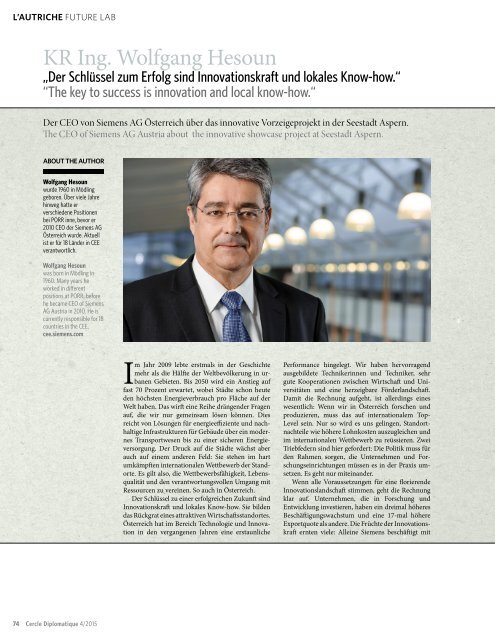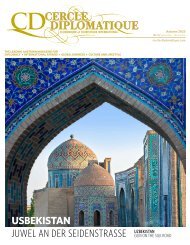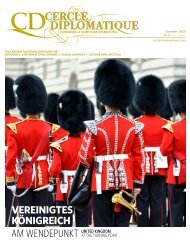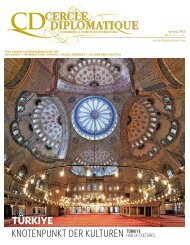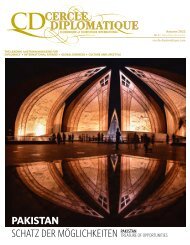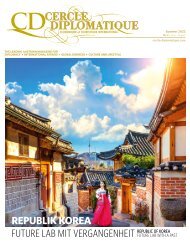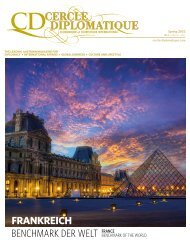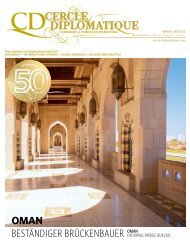CERCLE DIPLOMATIQUE - issue 04/2015
CD is an independent and impartial magazine and is the medium of communication between foreign representatives of international and UN-organisations based in Vienna and the Austrian political classes, business, culture and tourism. CD features up-to-date information about and for the diplomatic corps, international organisations, society, politics, business, tourism, fashion and culture. Furthermore CD introduces the new ambassadors in Austria and informs about designations, awards and top-events. Interviews with leading personalities, country reports from all over the world and the presentation of Austria as a host country complement the wide range oft he magazine.
CD is an independent and impartial magazine and is the medium of communication between foreign representatives of international and UN-organisations based in Vienna and the Austrian political classes, business, culture and tourism. CD features up-to-date information about and for the diplomatic corps, international organisations, society, politics, business, tourism, fashion and culture. Furthermore CD introduces the new ambassadors in Austria and informs about designations, awards and top-events. Interviews with leading personalities, country reports from all over the world and the presentation of Austria as a host country complement the wide range oft he magazine.
You also want an ePaper? Increase the reach of your titles
YUMPU automatically turns print PDFs into web optimized ePapers that Google loves.
L’AUTRICHE FUTURE LAB<br />
KR Ing. Wolfgang Hesoun<br />
„Der Schlüssel zum Erfolg sind Innovationskraft und lokales Know-how.“<br />
“The key to success is innovation and local know-how.“<br />
Die Forschungsgesellschaft<br />
ASCR<br />
Aspern Smart City<br />
Research<br />
Der CEO von Siemens AG Österreich über das innovative Vorzeigeprojekt in der Seestadt Aspern.<br />
The CEO of Siemens AG Austria about the innovative showcase project at Seestadt Aspern.<br />
ABOUT THE AUTHOR<br />
Wolfgang Hesoun<br />
wurde 1960 in Mödling<br />
geboren. Über viele Jahre<br />
hinweg hatte er<br />
verschiedene Positionen<br />
bei PORR inne, bevor er<br />
2010 CEO der Siemens AG<br />
Österreich wurde. Aktuell<br />
ist er für 18 Länder in CEE<br />
verantwortlich.<br />
Wolfgang Hesoun<br />
was born in Mödling in<br />
1960. Many years he<br />
worked in different<br />
positions at PORR, before<br />
he became CEO of Siemens<br />
AG Austria in 2010. He is<br />
currently responsible for 18<br />
countries in the CEE.<br />
cee.siemens.com<br />
Im Jahr 2009 lebte erstmals in der Geschichte<br />
mehr als die Hälfte der Weltbevölkerung in urbanen<br />
Gebieten. Bis 2050 wird ein Anstieg auf<br />
fast 70 Prozent erwartet, wobei Städte schon heute<br />
den höchsten Energieverbrauch pro Fläche auf der<br />
Welt haben. Das wirft eine Reihe drängender Fragen<br />
auf, die wir nur gemeinsam lösen können. Dies<br />
reicht von Lösungen für energieeffiziente und nachhaltige<br />
Infrastrukturen für Gebäude über ein modernes<br />
Transportwesen bis zu einer sicheren Energieversorgung.<br />
Der Druck auf die Städte wächst aber<br />
auch auf einem anderen Feld: Sie stehen im hart<br />
umkämpften internationalen Wettbewerb der Standorte.<br />
Es gilt also, die Wettbewerbsfähigkeit, Lebensqualität<br />
und den verantwortungsvollen Umgang mit<br />
Ressourcen zu vereinen. So auch in Österreich.<br />
Der Schlüssel zu einer erfolgreichen Zukunft sind<br />
Innovationskraft und lokales Know-how. Sie bilden<br />
das Rückgrat eines attraktiven Wirtschaftsstandortes.<br />
Österreich hat im Bereich Technologie und Innovation<br />
in den vergangenen Jahren eine erstaunliche<br />
Performance hingelegt. Wir haben hervorragend<br />
ausgebildete Technikerinnen und Techniker, sehr<br />
gute Kooperationen zwischen Wirtschaft und Universitäten<br />
und eine herzeigbare Förderlandschaft.<br />
Damit die Rechnung aufgeht, ist allerdings eines<br />
wesentlich: Wenn wir in Österreich forschen und<br />
produzieren, muss das auf internationalem Top-<br />
Level sein. Nur so wird es uns gelingen, Standortnachteile<br />
wie höhere Lohnkosten auszugleichen und<br />
im internationalen Wettbewerb zu reüssieren. Zwei<br />
Triebfedern sind hier gefordert: Die Politik muss für<br />
den Rahmen sorgen, die Unternehmen und Forschungseinrichtungen<br />
müssen es in der Praxis umsetzen.<br />
Es geht nur miteinander.<br />
Wenn alle Voraussetzungen für eine florierende<br />
Innovationslandschaft stimmen, geht die Rechnung<br />
klar auf. Unternehmen, die in Forschung und<br />
Entwicklung investieren, haben ein dreimal höheres<br />
Beschäftigungswachstum und eine 17-mal höhere<br />
Exportquote als andere. Die Früchte der Innovationskraft<br />
ernten viele: Alleine Siemens beschäftigt mit<br />
PHOTOS: RITA NEWMAN, MARKUS ROESSLE<br />
sechs Werken und lokaler Kompetenz in jedem<br />
Bundesland rund 6.600 weitere Lieferanten und<br />
Geschäftspartner in ganz Österreich.<br />
Siemens investiert und forscht ganz bewusst in<br />
Österreich. Wir bündeln hier eine Vielzahl von Forschungsaktivitäten<br />
für urbane Ballungsräume. Als<br />
kleines Land kann Österreich intelligente Technologien<br />
früh installieren und testen – ein klarer Vorteil,<br />
mit dem wir internationales Vorbild sein können.<br />
Die Forschungsgesellschaft in der Seestadt<br />
Aspern hat bereits eine solche Vorbildwirkung. Wir<br />
legen hier die Basis zur Energieoptimierung ganzer<br />
Stadtteile. Das Besondere daran ist, dass im realen<br />
urbanen Umfeld gearbeitet wird; nicht im Labor,<br />
sondern gemeinsam mit den künftigen Bewohnern<br />
vor Ort. Im Fokus steht die intelligente Vernetzung<br />
von Technologien bzw. Energieerzeugungs- und<br />
Speicherarten. Das gemeinsame Ziel: mehr Intelligenz<br />
in die Städte der Zukunft zu bringen. Es ist für<br />
Österreich von wesentlicher Bedeutung, dieses<br />
europa weit einzigartige Vorzeigeprojekt der Energieforschung<br />
in Wien zu haben. Die Innovationen, die<br />
wir in Aspern gewinnen, werden nicht nur den<br />
Standort stärken und Exportchancen generieren,<br />
sondern bilden auch die Basis für weitere Wertschöpfung<br />
im Land.<br />
In 2009, for the first time in history, more than<br />
half the world’s population lived in urban areas.<br />
By 2050, an increase of almost 70% is expected<br />
where cities already have the highest energy consumption<br />
per unit area in the world. It raises a number<br />
of pressing <strong>issue</strong>s that we can only solve together.<br />
This ranges from solutions for energy efficient and<br />
sustainable infrastructure for buildings, modern<br />
transportation to a secure energy supply. The pressure<br />
on cities also covers other concerns: the highly<br />
competitive international competition between locations.<br />
There is a need to combine competitiveness,<br />
quality of life and responsible use of resources, which<br />
also applies to Austria.<br />
The key to a successful future is innovation and<br />
local expertise. They form the backbone of an attractive<br />
business location. Austria has shown an amazing<br />
performance in the areas of technology and innovation<br />
in recent years. We have highly trained technicians<br />
and engineers, a very good collaboration between<br />
industry and universities and a commendable<br />
funding landscape. In order to ensure results, one<br />
Vorbild. Seestadt Aspern als neuer Stadtteil Wiens.<br />
Best practice. Seestadt Aspern as new part of Vienna's city.<br />
thing is of utmost importance: research and production<br />
in Austria has to be at top international level.<br />
Only then will we be able to compensate for location<br />
disadvantages such as higher labour costs and to succeed<br />
in international competition. Two driving factors<br />
are required here: the policy must ensure the<br />
framework, companies and research institutions<br />
have to implement it in practice. It only works together.<br />
Once the conditions for a thriving innovation<br />
landscape are met, then we will gain the pay off.<br />
Companies that invest in research and development<br />
achieve a three times higher employment growth<br />
and a 17-times higher export rate than others. Many<br />
reap the benefits of innovation. Siemens alone, with<br />
six plants and local expertise in each province, deals<br />
with around 6,600 suppliers and business partners<br />
throughout Austria.<br />
Siemens invests and researches very deliberately<br />
in Austria. We bundle a variety of research activities<br />
for metropolitan areas. As a small country, Austria<br />
can install and test intelligent technologies early – a<br />
clear advantage, with which we can be an international<br />
role model.<br />
The research company in Seestadt Aspern has<br />
been such a role model. Here, we lay the foundation<br />
for energy optimisation of entire metropolitan areas.<br />
The remarkable aspect is that we are working in a real<br />
urban environment; not in the lab, but with the future<br />
residents on site. The focus is on intelligent networking<br />
of technologies, energy production and storage<br />
types. Our common goal is to inject more intelligence<br />
into the cities of the future. This unique European<br />
model project for energy research in Vienna is essential<br />
for Austria. The innovations that we bring about<br />
in Aspern will not only strengthen the location and<br />
generate export opportunities, but also form the basis<br />
for further value creation in the country.<br />
ASCR (Aspern Smart City<br />
Research) wurde 2013 von<br />
Siemens, Wien Energie,<br />
Wiener Netze und der<br />
Stadt Wien ins Leben<br />
gerufen. Über 100<br />
Personen aus unterschiedlichen<br />
wissenschaftlichen<br />
Bereichen sind an diesem<br />
Forschungsvorhaben direkt<br />
beteiligt. Die ASCR führt<br />
eines der innovativsten<br />
und nachhaltigsten<br />
Energieeffizienz-Demonstrationsprojekte<br />
Europas<br />
durch. Neben der Größe<br />
und Konstellation<br />
(stadtnahe Unternehmen<br />
und Industrie) sticht vor<br />
allem der integrative<br />
Ansatz hervor. Nicht<br />
Einzelelemente, sondern<br />
komplexe Zusammenhänge<br />
werden anhand von<br />
Daten aus dem realen<br />
Leben eines neu<br />
errichteten Stadtquartiers<br />
mit realen Endkunden<br />
erforscht.<br />
ASCR (Aspern Smart City<br />
Research) was founded in<br />
2013 by Siemens, Wien<br />
Energie, Wiener Netze and<br />
the City of Vienna. Over<br />
100 people from different<br />
scientific areas are directly<br />
involved in this research<br />
project. The ASCR carries<br />
out one of the most<br />
innovative and sustainable<br />
energy efficiency<br />
demonstration projects in<br />
Europe. Besides the size<br />
and constellation (urban<br />
enterprises and industry),<br />
the integrative approach is<br />
especially noteworthy.<br />
Complex relationships<br />
rather than individual<br />
elements are explored,<br />
using real life data from a<br />
newly built city district<br />
with real end users.<br />
ascr.at<br />
74 Cercle Diplomatique 4/<strong>2015</strong><br />
Cercle Diplomatique 4/<strong>2015</strong><br />
75


